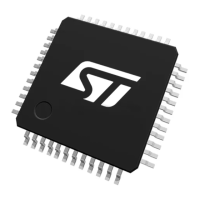Reset and clock control (RCC) RM0444
170/1390 RM0444 Rev 5
An interrupt can be generated when the PLL is ready, if enabled in the Clock interrupt
enable register (RCC_CIER).
The enable bit of each PLL output clock (PLLPEN, PLLQEN, and PLLREN) can be modified
at any time without stopping the PLL. PLLREN cannot be cleared if PLLRCLK is used as
system clock.
5.2.5 LSE clock
The LSE crystal is a 32.768 kHz crystal or ceramic resonator. It has the advantage of
providing a low-power but highly accurate clock source to the real-time clock peripheral
(RTC) for clock/calendar or other timing functions.
The LSE crystal is switched on and off using the LSEON bit in RTC domain control register
(RCC_BDCR). The crystal oscillator driving strength can be changed at runtime using the
LSEDRV[1:0] bits in the RTC domain control register (RCC_BDCR) to obtain the best
compromise between robustness and short start-up time on one side and low-power-
consumption on the other side. The LSE drive can be decreased to the lower drive
capability (LSEDRV=00) when the LSE is ON. However, once LSEDRV is selected, the
drive capability can not be increased if LSEON=1.
The LSERDY flag in the RTC domain control register (RCC_BDCR) indicates whether the
LSE crystal is stable or not. At startup, the LSE crystal output clock signal is not released
until this bit is set by hardware. An interrupt can be generated if enabled in the Clock
interrupt enable register (RCC_CIER).
External source (LSE bypass)
In this mode, an external clock source must be provided. It can have a frequency of up to
1 MHz. This mode is selected by setting the LSEBYP and LSEON bits in the AHB peripheral
clock enable in Sleep/Stop mode register (RCC_AHBSMENR). The external clock signal
(square, sinus or triangle) with ~50 % duty cycle has to drive the OSC32_IN pin while the
OSC32_OUT pin can be used as GPIO. See Figure 11.
5.2.6 LSI clock
The LSI RC acts as a low-power clock source that can be kept running in Stop and Standby
mode for the independent watchdog (IWDG) and RTC. The clock frequency is 32 kHz. For
more details, refer to the electrical characteristics section of the datasheets.
The LSI RC can be switched on and off using the LSION bit in the Control/status register
(RCC_CSR).
The LSIRDY flag in the Control/status register (RCC_CSR) indicates if the LSI oscillator is
stable or not. At startup, the clock is not released until this bit is set by hardware. An
interrupt can be generated if enabled in the Clock interrupt enable register (RCC_CIER).

